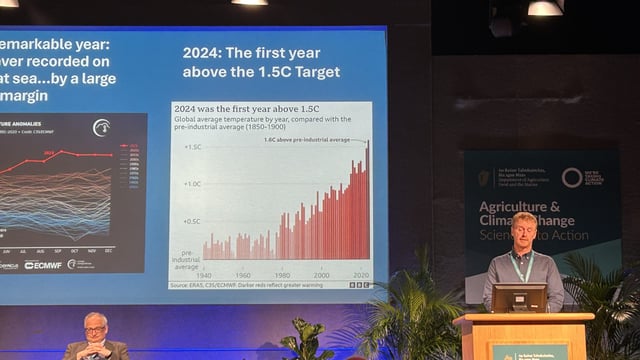Spring 2025 had highest average temperatures in over 100 years
Spring 2025 was the warmest on record for Ireland, with highest sunshine totals and average temperatures recorded at most stations for the period of March, April and May.
Provisional Met Éireann statistics show that spring 2025 had the highest average temperature for the meteorological period in 126 years of records.
Notably, 2025 marked the first spring that was more than 2°C higher than the 20th century average for the same period.
Of the top five average temperatures for spring, four have occurred since 2017, reflecting the trend of increasing seasonal temperatures aligned with global climate projections.
Overall, it was the sunniest spring on record, with most stations recording highest values for total hours of sunshine in spring.
Spring 2025 was also relatively dry, provisionally ranking as the 16th driest since records began in 1941, and the driest since 2020.
As a result of the warmer, sunnier and calmer conditions, a marine heatwave developed off the west coast of Ireland through April and May with sea surface temperatures reaching over 2°C warmer than average in some coastal areas, and up to 4°C warmer than average in offshore areas.
Mild temperatures and sunny
The latest Met Éireann statistics show that Ireland had its warmest and sunniest meteorological spring on record this year, in terms of average temperatures.
It was also dry everywhere with multiple climatological dry periods. Blocking high pressure dominated through most of the season, bringing a lot of sunshine with it.
This, along with predominantly easterly winds due to the high-pressure systems often setting up just to the north of Ireland and the UK, led to sea surface temperatures to the south and west of Ireland reaching record high levels during April and May.
All three months saw air temperatures well above average at the majority of stations, leading to all but a few stations in the east having their warmest spring on record.
March was mild, dry and sunny, with high pressure dominating through most of the month with weak steering currents aloft.
April was warm and sunny overall. The first half of the month was dominated by high pressure to the north bringing a dry easterly airflow and high average temperatures.
The second half of the month saw a wetter spell for a couple of weeks, where Atlantic low pressure dominated and brought several spells of heavy rain, especially to the midlands, south and east.
It settled down again towards the end of the month with high pressure bringing record warmth for April.
May continued the theme of high-pressure dominance for much of the month. Blocking high pressure set up just to the north brought an easterly airflow with plenty of sunshine.
The settled spell broke for the last week of the season, with Atlantic low pressure breaking through and bringing spells of rain or showers.
Rainfall
All seasonal rainfall totals across the country were below their 1991-2020 Long-Term Average (LTA), according to Met Éireann.
Percentages of seasonal rainfall values ranged from 57% (the season’s lowest rainfall total of 129.5mm) at Sherkin Island, Co. Cork (driest spring since 1997) to 92% (seasonal rainfall total of 152.8mm) at Casement Aerodrome, Co. Dublin.
Seasonal rainfall totals were as much as 250.3mm (77% of its LTA) at Newport, Co. Mayo (its driest spring since 2012).
The highest daily rainfall total was 44.5mm at Roches Point, Co. Cork on Friday, April 18.
The number of rain days ranged from 31 days at Moore Park, Co. Cork, to 42 days at both Newport, Co. Mayo and Belmullet, Co. Mayo.
The number of wet days ranged from 19 days at Roches Point, Co. Cork, to 35 days at Belmullet, Co. Mayo.
The number of very wet days ranged from three days at Malin Head, Co. Donegal to eight days at both Newport, Co. Mayo and Finner, Co. Donegal.
There were numerous climatological dry periods during spring 2025, with eight stations having two dry periods at different times during the season.
Climatological dry periods are classified as dry spells, absolute droughts and partial droughts.
Three stations had partial droughts, 11 stations had absolute droughts and 22 stations had dry spells. Along with Sherkin Island, it was also the driest spring since 1997 at Moore Park, Co. Cork and Valentia Observatory, Co. Kerry..
Wind
Seasonal mean wind speeds ranged from 5.3 knots (9.8km/h) at Ballyhaise, Co. Cavan to 12.2 knots (22.6km/h) at Malin Head, Co. Donegal.
Gales were reported on Friday, March 28 and on Sunday, May 25 at Mace Head, Co. Galway. The number of days with gale force winds ranged from zero at most stations to two days at Mace Head, Co. Galway.
There were no strong gales or storms reported this season.
The season’s highest gust was reported at Malin Head, Co. Donegal on Saturday, March 29 with 46 knots (85km/h).
The season’s highest 10-minute mean wind speed was 34 knots (62km/h) at Mace Head, Co. Galway, reported on Sunday, May 25 and Friday, March 28. Seven stations had their lowest mean wind for spring on record.





